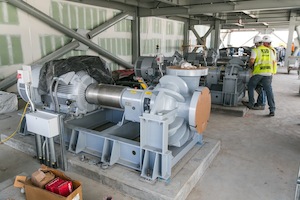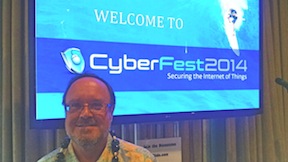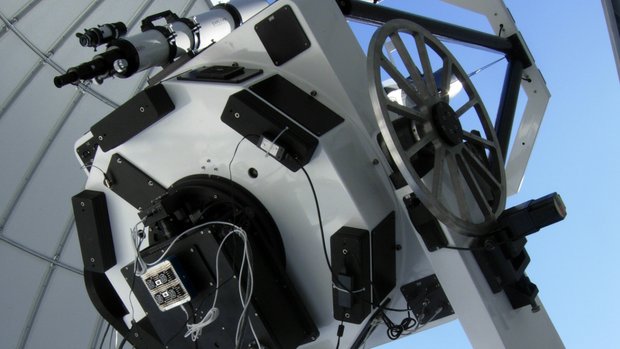Daily Business Report — Oct. 2, 2014
Poseidon Water’s desalination plant in Carlsbad, now about 65 percent complete, will produce 50 million gallons of water a day for use across the San Diego region.
Seawater Desalination Project
In Carlsbad Nears Completion
CARLSBAD — The largest seawater desalination project in the Western Hemisphere is 65 percent complete and on schedule for delivering drought-proof water supplies to the San Diego County Water Authority next fall.

The $1 billion project will produce 50 million gallons of water a day for use across the San Diego region, providing a major resource that will meet about 7 percent of the county’s need for water in 2020 and account for about one-third of all locally generated water. This new water supply and its cost will be combined with the Water Authority’s other supplies serving 24 local water agencies, 3.2 million people and a $206 billion economy.
“We couldn’t be more pleased with the progress on this world-class project, and we are eager to show the world what it can do,” said Peter MacLaggan, vice president of Poseidon Water, the project’s private developer. “Our contractors and our host communities of Carlsbad, San Marcos and Vista have set a new standard for cooperation and efficiency, and that has allowed us to make fantastic progress during nearly two years of construction.”
The first day of October begins the “water year” for resource managers — the start of the season when snow and rain collects for use the following calendar year. After three dry winters, the next several months are pivotal for California; below-average precipitation could lead to more mandatory water-use restrictions statewide.
“As drought conditions deepen statewide, the value of the Carlsbad Desalination Project continues to grow for San Diego County,” said Mark Weston, Chair of the Water Authority’s board of directors.
The desalination plant, which sits on about six acres of public utility zoned land next to the Encina Power Station and Agua Hedionda Lagoon, will produce up to 56,000 acre-feet of water annually — enough to serve about 112,000 typical homes.
When construction is complete, Poseidon will seek a drinking water permit for commercial operations from the State Water Resources Control Board and perform start-up testing for water delivery starting as soon as fall 2015.
In the San Diego region, officials are developing plans for a desalination plant on Camp Pendleton. Though it’s still in the early stages, the project could produce three times the amount of drinking water as the Carlsbad facility, officials say.

City Auditor Lets Former Balboa Park
Centennial Planners Off The Hook
The former organizers of a yearlong celebration of Balboa Park’s centennial did not misuse city funds but didn’t always follow proper procedures either, according to a report released Wednesday by the San Diego City Auditor.
Balboa Park Centennial Inc. was formed by the city to put on a big public celebration of the park’s 100th birthday, but the group disbanded when it failed to find major sponsors. Centennial planning is now being handled by the city and the park’s cultural organizations.
BPCI faced allegations that some of the $1.6 million received from the city was misspent, with financial records kept from public view.
“In our analysis of BPCI’s expenditures, we found that BPCI complied with the funding agreement’s use of funds requirements,” the audit says.
It goes on to say the range of allowable expenses were broad, but both the spending and required reporting to the city met the guidelines.
On the other hand, the organization did not fully comply with a section of a memorandum of understanding with the city that governs procurement of goods and services when it came to hiring contractors to help plan and carry off the celebration, according to the auditor.
“We found several instances where BPCI awarded contracts without going through the required procurement processes,” the audit says.
The finding, however, was qualified by the auditor’s reference to communications from BPCI to the City Attorney’s Office that sought guidance on such matters. The City Attorney’s Office had said that the MOU did not require such procedures, however, there might be other city ordinances that required BPCI to do so.
The study found that contractors, vendors and executives delivered on what they were hired to do, given the broad scope of work set forth in the contracts.
City management and BPCI officials generally agreed with the findings of the audit, and some detailed comments were sprinkled throughout the report, the audit says.Gerry Braun, who served as BPCI’s spokesman, declined to comment.
— City News Service

1-Bedroom Apartments in Downtown’s
Harborview Among Nation’s Costliest
The Harborview apartments in Downtown San Diego were among the 14 most expensive neighborhoods for renters in 2014, according to a list compiled by Apartments.com. Monthly rents for one-bedroom apartments at the complex, located at 820 West G St., are $2,206, according to Apartments.com. That landed the apartments in the No. 10 spot on the list.
“We’re seeing renters paying a premium to live in the hottest neighborhoods, which goes to show it truly is all about location, location, location,” said Brad Long, president of Apartments.com. “These renters are willing to spend a rather significant portion of their overall income on monthly rent, in order to afford the luxury of living in exclusive areas.”
The national average cost of rent for a one-bedroom apartment in August was $939, according to CoStar. But even the least expensive of the list of 14 will set renters back at least twice that amount.
The top monthly rent for a one-bedroom apartment was $4,440 at Penn Plaza in the Garment District of New York City.

Growing Internet Access by Common
Devices Brings Security Challenges
Cybersecurity experts meeting in San Diego on Wednesday warned that growing Internet access by common physical devices brings security challenges along with benefits for society.
“Your air-conditioner now talks on the Internet … and by the way it’s connected into your network even if you don’t know it,” said Christian Byrnes of Gartner Inc., an international technology research firm. “Every industry is going to be impacted by the Inernet of things. It’s going to be an exciting decade.”
Byrnes spoke at CyberFest2014, a conference sponsored by Securing our eCity Foundation and ESET, an international security software company with U.S. headquarters in San Diego. The conference was held at Stone Brewing in Liberty Sation.
Byrnes said all business operations face cybersecurity risk but it is important to strike a balance. “Locking everything down” isn’t an option, he said. “Every new generation of computing has brought this issue to the table.”
Don Bailey of Lab Mouse Security in Denver was optimistic about overcoming the security challenges, asserting that security technology is generally improving. “People who are selling fear are wasting your time. I’m here to talk about the solution,” he said. “Today we have a lot more technology and metrics to identify whether somebody has been hacked.”
He said the leading problem is a failure to prioritize risks. “Things are going to get hacked,” he said, but “we have more security controls than ever before.”
— Times of San Diego
‘Computer Cop’ Software Provided
By San Diego DA Has Security Flaws

Authorities in San Diego on Wednesday issued a warning about the misuse of Internet-monitoring software designed to help parents protect their children from becoming victims of online predators and bullying.
The “Computer Cop” software allows parents to quickly scan photos, videos, emails and chat messages on their children’s computers, looking for inappropriate content.
According to the District Attorney’s Office, recent reports have pointed out some privacy issues with the software, which — like most online tools — can be misused in the hands of crooks.
The issues can be easily corrected and the District Attorney’s Office is suggesting users of “Computer Cop” software protect their online privacy by not using the key stroke-logging feature and removing the software disc from the computer when not in use.
The Electronic Frontier Foudation, a nonprofit civil liberties organization based in San Francisco, has reported extensively on “Computer Cop,” and found it lacking in many ways.
The way ComputerCOP works is neither safe nor secure. It isn’t particularly effective either, except for generating positive PR for the law enforcement agencies distributing it. As security software goes, we observed a product with a keystroke-capturing function, also called a “keylogger,” that could place a family’s personal information at extreme risk by transmitting what a user types over the Internet to third-party servers without encryption. That means many versions of ComputerCOP leave children (and their parents, guests, friends, and anyone using the affected computer) exposed to the same predators, identity thieves, and bullies that police claim the software protects against.
The San Diego County District Attorney’s Office provided the “Computer Cop” software to parents free of charge, in part due to an increase in prosecutions of Internet predators.
— City News Service
Harbor Packaging Acquired
By Minneapolis Company
Liberty Diversified International of Minneapolis (LDI) has acquired San Diego County-based Harbor Packaging Inc., a designer and manufacturer of corrugated packaging and Point of Purchase displays in Southern California and Mexico. Harbor Packaging has manufacturing and warehousing facilities in Poway as well as Tijuana and Mexicali, Mexico. Financial terms were not disclosed.
The Harbor Packaging brand will remain intact and will be managed as a sister company to LDI’s Liberty Carton-Mexico operation, which has manufacturing, warehousing and fulfillment functions in Mexicali.
Leading the new organization will be Bob Walton, former Harbor Packaging president and CEO, who has been named LDI vice president, packaging, Southwest U.S. and Mexico. The combined Harbor operations employ approximately 225 people, with slightly more than half in the U.S.
Products and services sold by the combined operation in the Southwest U.S. and Mexico will include stock containers, custom packaging, printing/labeling, custom package design, plus fulfillment and logistics for timely delivery.

Corporate Directors Forum
Presents Director of the Year Awards
Corporate Directors Forum has recognized six San Diego directors for their high standards in corporate governance at its annual Director of the Year awards. The awards were presented Sept. 23 at the Hyatt Regency La Jolla to celebrate directors who have made a significant positive contribution in the board room and behind the scenes. The directors recognized are:
• Frederick T. Muto, director, Isis Pharmaceuticals Inc., honored as Director of the Year for Corporate Governance.
• Gerald T. Proehl, president, CEO and director, Santarus Inc., honored as Director of the Year for Enhancement of Economic Value.
• John W. Kozarich, Ph.D., chairman, Ligand Pharmaceuticals Inc., honored as Director of the Year for Companies in Transition.
• Susan R. Salka, president and CEO, AMN Healthcare, honored as Director of the Year for Corporate Citizenship.
• Kathleen Sellick, former president and CEO, Rady Children’s Hospital, honored as Director of the Year for Corporate Governance, Not-for-Profit Board.
• Karin Eastham, director, various boards, recognized for Lifetime Achievement in Corporate Governance.
Belching Beaver to Open Brewpub
VISTA — Belching Beaver, a craft beer maker based in Vista, plans to open a brewpub in Vista in a 6,740-square-foot building that used to house a branch of First National Bank. The company purchased the building, located at 302 E. Broadway, for $1.35 million.
FDA Approves Trials of Local
Biotech’s Alzheimer’s Drug
San Diego-based NeuroGenetic Pharmaceuticals Inc. said Wednesday the Food and Drug Administration has approved clinical trials of its NGP 555 compound to treat and prevent Alzheimer’s disease.
The approval follows successful pre-clinical toxicology and safety studies of the drug under federal grants totaling $3.4 million.
“NGP 555 prevented the formation of and the deposition of amyloid plaques, thereby precluding neuronal cell death and the dementia associated with (Alzheimer’s disease),” saud Dr. William T. Comer, CEO of the privately held biopharmaceutical company.
Comer said NeuroGenetic anticipates it will begin Phase I human clinical trials by the end of 2014.
The company was founded in 2009 to develop innovative drug therapies for Alzheimer’s disease, which affects 5.5 million Americans.
— Times of San Diego

Construction Begins on Temporary East Village Park
Just over a year ago, a group of architecture students had an idea to temporarily lease a vacant lot and turn it into a park.
On Wednesday, the students’ idea took concrete form with a groundbreaking ceremony for their park at Park and Market streets in San Diego’s East Village. The students have since graduated from the NewSchool of Architecture and Design and formed a company called RAD Lab. It works on this and other Downtown projects.
The lot just a few blocks north of Petco Park is owned by Civic San Diego, the nonprofit created to replace the city’s dissolved redevelopment agency.
Reese Jarrett, the new president of Civic San Diego, said his organization hopes to build housing, retail and commercial space on the site in the future.
“But in the meantime, what happens to the space?” he said. “Well, RAD Lab has answered the question for us by creating this exciting opportunity of open space, public engagement and place making.”
David Loewenstein, chief operating officer of RAD Lab, said the temporary park fills a need in downtown.
“In the middle of East Village, you see a lot of high-rises, a lot of residential, not a lot of public parks, or a lot of urban parks specifically,” he said. “So our vision and goal was to create something new, something different, something for the community, and something we could all enjoy.”
The park, which RAD Lab named Quartyard, will include a dog run, event space and a beer garden. It will be made with reusable materials, including shipping containers, and was designed to be set up quickly, so it should be open by December.
— KPBS
UC San Diego Part of New Effort
To Fight Autoimmune Disorders
The Division of Rheumatology, Allergy and Immunology at the UC San Diego School of Medicine has been named a key site in a national, multi-institution, multi-year $41.6 million program to speed drug discovery, development, diagnostics and therapies for patients with autoimmune disorders, primarily rheumatoid arthritis and lupus erythematosus, which affect millions of Americans.
“We will be looking to pinpoint the genes, proteins, chemical pathways and networks involved in these diseases at the single cell level,” said Gary S. Firestein, professor, dean and associate vice chancellor of translational medicine. “This approach allows us to make comparisons across many diseases, revealing new insights and aspects of the disease process. We hope to better understand why some RA (rheumatoid arthritis) patients, for example, respond to therapy and others do not — and develop new therapies that target their condition based upon their particular genetic and environmental variables.”
If successful, the researchers said the combined efforts of academia, the NIH and biotechnology companies can change the way research is performed and create multi-disciplinary teams that can be more effective than individual groups.
From Gaugin to Warhol
San Diego Museum of Art
Traces Path of Modern Art

Masterpieces by more than 40 monumental artists — from Gauguin to Warhol — are featured in a current exhibit at the San Diego Museum of Art in Balboa Park.
“Gauguin to Warhol: 20th Century Icons from the Albright-Knox Art Gallery” traces the path of modern art through a survey of iconic 20th century works from the Albright-Knox Art Gallery’s renowned collection.
The exhibition presents an opportunity to witness the development of the major movements that shaped the course of modern art from the late 19th century to the present.
Masterpieces include works by Pablo Picasso, Henri Matisse, Georgia O’Keeffe, Salvador Dalí, and Frida Kahlo, among others.
The scope of the show begins in the late 1800s, featuring milestones of Post-Impressionism by Henri de Toulouse-Lautrec, Vincent Van Gogh, and Paul Gauguin, and extends to the mid-20th century in America with Abstract Expressionists such as Jackson Pollock, Mark Rothko, Lee Krasner, Willem de Kooning, and Robert Motherwell as well as prominent Pop artists such as Roy Lichtenstein and Andy Warhol.
Through an impressive and encompassing array of works, the exhibition showcases the major aesthetic and philosophical themes of 20th century art.
The exhibition will run through Jan. 27, 2015.



